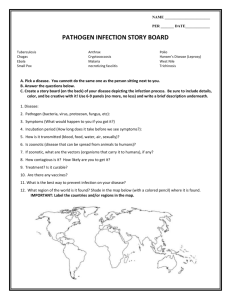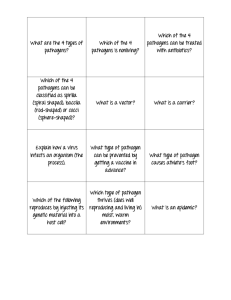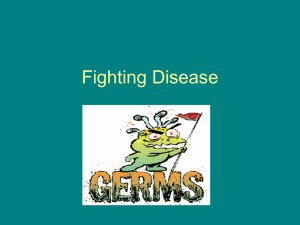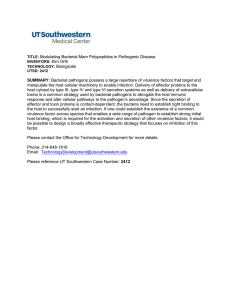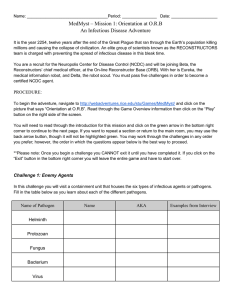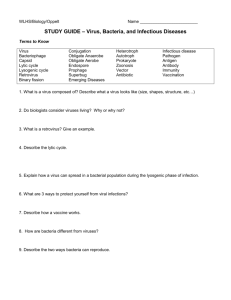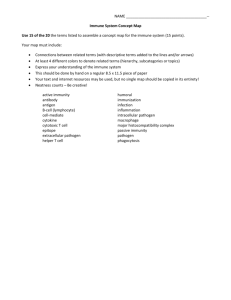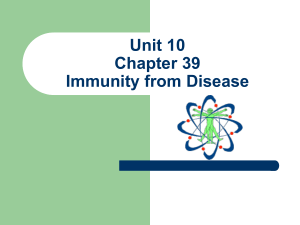Host-Pathogen Interactions Chapter 4 - Lesson 4 Introduction Koch’s Postulates: Experimental Steps
advertisement
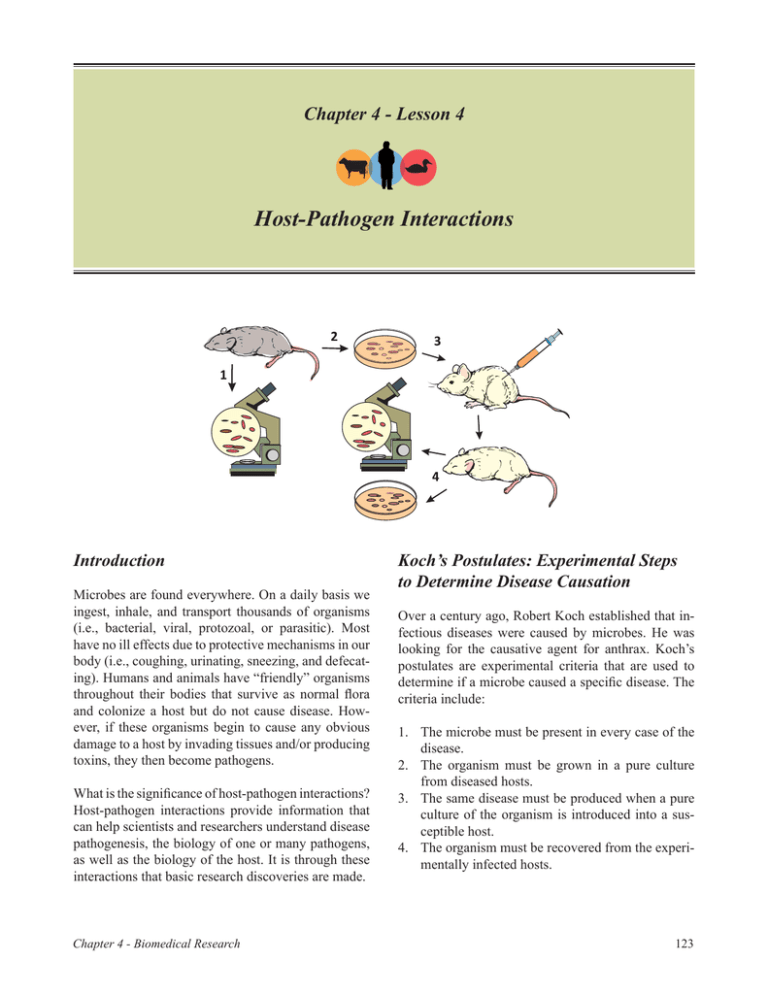
Chapter 4 - Lesson 4 Host-Pathogen Interactions Introduction Microbes are found everywhere. On a daily basis we ingest, inhale, and transport thousands of organisms (i.e., bacterial, viral, protozoal, or parasitic). Most have no ill effects due to protective mechanisms in our body (i.e., coughing, urinating, sneezing, and defecating). Humans and animals have “friendly” organisms throughout their bodies that survive as normal flora and colonize a host but do not cause disease. However, if these organisms begin to cause any obvious damage to a host by invading tissues and/or producing toxins, they then become pathogens. What is the significance of host-pathogen interactions? Host-pathogen interactions provide information that can help scientists and researchers understand disease pathogenesis, the biology of one or many pathogens, as well as the biology of the host. It is through these interactions that basic research discoveries are made. Chapter 4 - Biomedical Research Koch’s Postulates: Experimental Steps to Determine Disease Causation Over a century ago, Robert Koch established that infectious diseases were caused by microbes. He was looking for the causative agent for anthrax. Koch’s postulates are experimental criteria that are used to determine if a microbe caused a specific disease. The criteria include: 1. The microbe must be present in every case of the disease. 2. The organism must be grown in a pure culture from diseased hosts. 3. The same disease must be produced when a pure culture of the organism is introduced into a susceptible host. 4. The organism must be recovered from the experimentally infected hosts. 123 Components ForThe Host Pathogen However, there are some exceptions to these criteria. These include: 4 1. Some organisms cannot be cultured in a lab and grown on artificial media. 2. Some pathogens can cause several disease conditions such as M. tuberculosis, which can cause lung disease and other diseases of the skin, bone, and internal organs. 3. There may be ethical reasons that do not allow testing, (i.e., human diseases with no animal model – smallpox, rubella). A hosts immunologic ability to eliminate or control the microbe 3 • • • Mutualism: In mutualism, both the microorganism and the body work together. An example of this relationship would be cows and the bacteria in their rumen. Bacterial cellulose facilitates digestion in the animal, while the bacteria benefit from nutrients in the rumen. Commensalism: In commensalism, either the body or the microorganism benefits, while the other is not affected by the interaction. Examples of this include microorganisms that make up the normal flora that inhabit the eyes. These organisms thrive on secretions and dead cells, but do not affect the host. Parasitism: In parasitism, one organism benefits at the expense of the other. For example, parasites use the gastrointestinal tract of a human or animal as an environment in which to reproduce. The Body’s Normal Flora The body contains two types of normal flora: 1) resident flora (survive for extended periods), and 2) transient flora (temporary). Normal flora help to provide defenses against invading pathogens by covering adherence sites, producing compounds toxic to other organisms, and preventing pathogens from consuming 124 Invasion of the host through primary barriers 2 Evasion of local and tissue host defenses by microbes Host-Pathogen Interactions An individual’s or animal’s skin and mucous membranes generate an environment for microorganisms to interact with the body. This interaction between the host and the organism is referred to as symbiosis. There are three forms of symbiotic relationships that can occur at an anatomical level. In order for this to take place the following components will need to occur: 1 Microbe replication, with or without spread in the body Components for the host pathogen interaction. available nutrients. For disease to occur there must be a change in the body’s environment, which, in turn, allows the pathogen to overcome the normal flora. This can occur through a change in the pH of the body or elimination of normal flora due to antibiotics. Host Defenses A microorganism will not be able to invade unless it overcomes an animal’s or individual’s host defenses. Specific host defenses may include: • • • • Skin and mucosal secretions Non-specific local responses (e.g., pH) Non-specific inflammatory responses Specific immune responses (e.g., lymphocytes) The ability for a pathogen to overcome host defenses can be accomplished by two distinct components: a primary pathogen (causes disease in a healthy host) or opportunistic pathogen (causes disease if host is immunocompromised). Pathogen Defenses Pathogens contain virulence factors that promote disease formation and provide the opportunity for a microbe to infect and cause disease. The greater the Chapter 4 - Biomedical Research virulence, the more likely disease will occur. Such factors include: • Ability of a pathogen to adhere to a host • Ability of a pathogen to colonize (overcome) a host • Ability of a pathogen to evade host defenses 1 - Transmission 2 - Adherence Mechanisms of Pathogenesis 3 - Invasion Pathogenesis is the method by which a disease can develop. This can occur through foodborne intoxication where the causative agent produces toxins in the body (e.g., botulism). Another route is the colonization of an invading pathogen on the host surface, which allows the pathogen to increase in numbers and produce toxins that are damaging to the host’s cells (e.g., Vibrio and Corynebacterium). 4 Colonization 5 - Evasion of host defenses 6 - Damage and disease to host tissues Pathogenesis can also occur by pathogens invading and breaching the body’s barrier in order to multiply. These organisms have mechanisms that will not allow macrophages (the body’s defense against pathogens) to destroy them. They can also evade antibody detection (e.g., tuberculosis and plague). Finally, organisms can invade tissues within the body and produce toxins (e.g., Shigella). The relationship between a host and pathogen is dynamic. Production of disease occurs through a process of steps. The first five mechanisms make up a pathogen’s invasiveness (i.e., ability to invade tissues). Transmission In order to begin infection and eventually cause disease, pathogens must find a transmission route. Transmission of an infectious agent can occur in many ways, but it is typically through exposed skin (e.g., a cut, abrasion, puncture, or wound) or mucous membranes (e.g., gastrointestinal tract, respiratory tract, or urogenital tract). Adherence Once the pathogen has gained access to the body, it must have some means of attaching itself to the host’s tissues. This attachment is called adherence and is a necessary step in pathogenicity. Microbes contain ligands, which are projections that attach host Chapter 4 - Biomedical Research 7 - Exit from the body 8 - Survival in the environment Mechanisms of pathogenesis. receptors or surface proteins. Pathogens may have specific adherence mechanisms to attach to cells or tissue surfaces. Examples of this include: 1) tissue tropism (i.e., pathogens that prefer specific tissues over others), 2) species specificity (i.e., pathogens that only infect certain species), and 3) genetic specificity (i.e., surface mutations that occur so previous antibodies do not recognize the invading pathogen). If a microorganism cannot adhere to a host cell membrane, disease will not occur. Invasion At this point, microbes begin to invade the host and produce a bacteremia (i.e., presence of bacteria in the bloodstream) or viremia (presence of a virus in the bloodstream). Microorganisms are exposed to many barriers after introduction into the host. Some bacteria are able to cause disease while remaining on the 125 epithelial barriers, while many need to penetrate that barrier. Once this barrier has been penetrated, these pathogens can multiply without competition. Colonization Colonization is the multiplication of pathogenic organisms where toxins are produced and the normal flora are overcome. During this stage, pathogens compete with normal flora for space and nutrients. Pathogens usually colonize host tissues that are in contact with the external environment. During colonization, the host begins to show signs of septicemia (i.e., blood infection where bacteria are reproducing). For infection to proceed an infectious dose should be determined. This is the minimal number of microbes necessary to establish infection. Certain pathogens are less contagious and therefore require larger numbers of pathogens to cause disease (i.e., 10-100 for Shigella and 1,000,000 for Salmonella). Evasion of Host Defenses After colonization, pathogens circumvent the host’s innate nd adapted defenses by phagocytosis. Multiple mechanisms are used by pathogens to evade a host’s immune system. For the innate system this includes: • • • • • Intracellular pathogens that live inside a host cell Avoid phagocyte recognition by producing capsules prevents phagocytosis Producing membrane damaging toxins which can kill phagocytes (e.g., leukocidins) Interfere with complement activation Survive in the phagocyte Three types of toxins are produced to cause damage: • • • Exotoxins: Proteins secreted by pathogens that cause damage to the host (botulinum toxin, tetanus toxin, hemolysin (ruptures red blood cells). Endotoxins: Toxic substances that are released when a cell is killed (Lipolysaccharides). Exoenzymes: Enzymes that function outside the host cells or tissues. These include coagulase (forms a fibrin clot that “hides” the microbe from phagocytosis), hyaluronidase (breaks connective tissues down), or fibrinase (breaks down blood clots to allow pathogens to continue spreading). Exiting the Host A pathogen must exit the body. This occurs through various routes. Examples include sneezing, coughing, diarrhea, coitus, pus, blood, or insect bites. Survival Outside the Host Finally, a pathogen must be able to survive in the environment long enough to be transmitted to another host. Some are hardy and can survive for several weeks before a new host is found. There are others that survive in animal reservoirs or require direct contact because they are fragile. Pathogens must also avoid adapted defenses. Pathogens can produce proteases (i.e., allow each pathogen to avoid antibodies) or catalases (i.e., prevents the digestion of an engulfed pathogen). They can also utilize antigenic variation to alter the antigen structure. In addition, pathogens can mimic host molecules, which can cause disease-related damage. Cause Damage or Disease to Host While Avoiding Host Defenses Damage can occur through direct or indirect pathways. Direct methods produce toxins, which are poisonous substances that produce toxemia within a host. 126 Mosquito. Photo, James Gathany, CDC. Chapter 4 - Biomedical Research Pathogens may exit the body through a cough or sneeze. CDC. Infectious Diseases: The Basics Disease Stages An infectious disease is a clinically evident deviation from health. It occurs when there is a parasitic relationship between a host and a microorganism. Several different factors influence a microorganism’s relationship to its host and level of severity. These include: Infections can be either subclicinical or inapparent. If clinical signs are seen, disease occurs. The incubation period is the time between infection and first appearance of signs or symptoms. This period depends on the dose level of microbes, microbe type, virulence, and host health. • • • • Pathogenicity: The ability to produce disease in a host organism. Virulence: The degree of pathogenicity of a microorganism. Determinants of virulence for a pathogen include a pathogen’s genetic, biochemical, or structural features. For example, one strain of influenza may only cause a fever and sore throat, while another may cause pneumonia or other serious respiratory condition. Infectivity: The level at which a microorganism is able to infect or invade a host. Transmissibility: The measure of a microorganism’s ability to spread from one host to the next. This can include both distance and number of affected individuals. Chapter 4 - Biomedical Research The prodromal period of 1 to 2 days follows incubation in some diseases. This includes early, mild signs/ symptoms such as, fatigue, muscle aches, and/or headache. Recovery occurs when signs/symptoms are subsiding but the host may remain more susceptible to secondary, opportunistic infections. During the convalescent period, the body returns to a pre-diseased state. Conclusion Microorganisms are located everywhere, and there are many more microbes than hosts. The goal for both host and microbe is survival. Infection can be localized, focal, or occur systemically. Several factors affect the balance between health and infectious disease. Pathogenesis depends on genetics, the state of host health, age, and stress. 127 References Sparling, P. F. Bacterial virulence and pathogenesis: an overview. Rev Infect Dis. 1983;5 (Suppl. 4):S637–S646. Wood, W. B., Davis, B. D. (1980). Host-parasite relations in bacterial infections. In: Davis, B. D., Dulbecco, R., Essen, H. N., & Ginsberg, H. S. (Eds.), Microbiology. (pp. 551–571). Cambridge, MA: Harper & Row. Questions 1. What is symbiosis? 2. 3. Define the following terms: a. Pathogenicity b.Virulence c.Infectivity d. Transmissibility Describe the mechanisms that must occur for pathogenesis to occur. 4. What are the components needed for a host-pathogen interaction to occur? 5. What are the different disease stages? Activity 1. Using the chart below, choose a disease agent and write a sentence to describe each mechanism of pathogenesis. Activity: Mechanisms of Pathogenesis In Animals Disease Agent: (e.g., Brucellosis) Agent Transmission Adherence Invasion Colonization Evasion of host defense Damage and disease to host tissues Exit from the body Survival in the environment In Humans Agent Transmission Adherence Invasion Colonization Evasion of host defense Damage and disease to host tissues Exit from the body Survival in the environment 128 Chapter 4 - Biomedical Research
